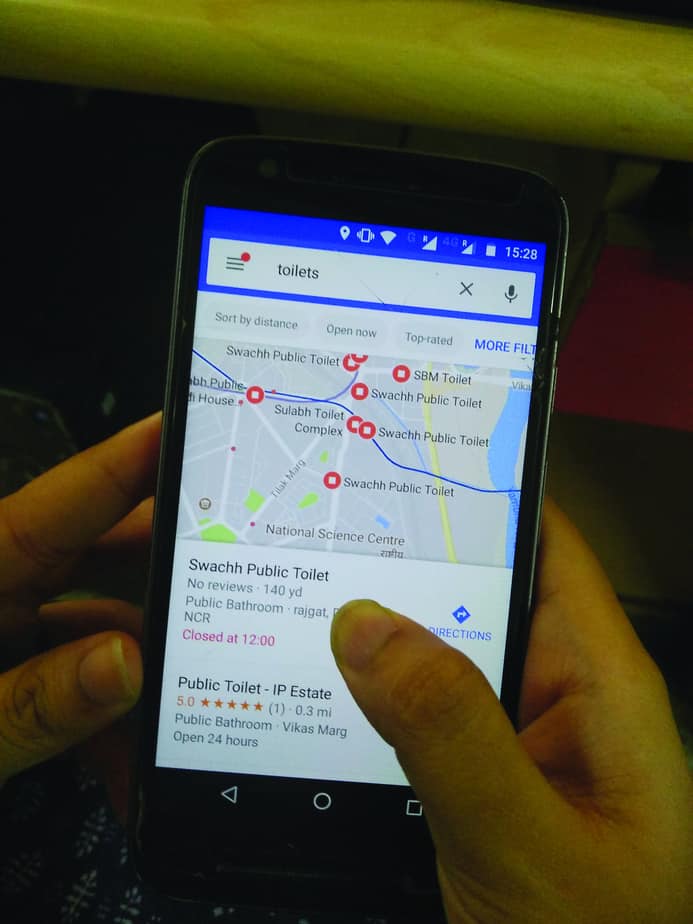
If you are looking for a public toilet in Delhi, locating them now is easy thanks to government’s toilet locators on google maps. However, chances are that you will have to hold your bladder as many of them turn out to be almost unusable, especially for women.
Unbearable stench, broken lights, lack of water, missing mugs and doors make the public toilets dysfunctional. There is a clear gap between the usability and availability of loos in the city.
The facilities for women are the worst. According to a survey conducted by ActionAid India (a Delhi based NGO) last year, two in every three public toilets did not have a separate provision for women. Out of the 229 toilets inspected, more than 50 per cent of the toilets did not have water facilities and lights, 30 per cent did not even have doors.
Scarcity of proper toilet facilities is a constant worry for street vendors and shoppers in several parts of the city. “Going to a public toilet is unthinkable. God knows what kind of diseases you can get if you use them,” says Alka, a shopper in Karol Bagh market.
Karol Bagh market area, one of the busiest markets in the city hardly has any public toilets. There area few in Gaffar market and one near the unkempt Tikona Park but the conditions are such that people avoid using them. “Men still manage in the open but it is extremely difficult for women. They have to relieve themselves in nearby restaurants and guesthouses,” says Sanjeev Kumar, resident of the area. The resident welfare association of the area claims that despite having several meetings with the officials of MCD, nothing has been done so far.
The situation in Chandni Chowk market is almost similar. Even though there are public restrooms in the area, most of them are unusable, with heavy stains on the walls and dirty tin mugs for washing. “I avoid using the public loo. I prefer going to the gurdwara where it is much cleaner,” says Zubeida, who sells bangles on the street.
Across the city there is an acute shortage of toilets for women. A recent report has revealed that out of 1,147 public toilets in South Delhi, only 67 toilets are allotted for women. In the entire Karol Bagh area, only two toilets have been built for women.
The markets in Chawri Bazaar have several well-maintained public toilets for men but close to none for women. In the Shahdara region of East Delhi, the toilets for women are in a terrible state. “There is no light or female staff in the facilities for ladies,” says Rajesh Agarwal, President of RWA of the region. Ajmeri Gate, Nizammudin West, Rajouri Garden all have the same story to tell.
The situation at night in some areas becomes dangerous. Due to lack of guards, the toilets become dens for addicts. In June 2017, addicts occupying public toilets murdered a 22-year-old caretaker and he lost his life while taking on the youths in outer Delhi’s Nangloi.
Most of the toilets are shut at night, leaving the public with no other option but to go out in the open. In Mayur Vihar Phase 1, only one toilet is shown as open 24 hours as per the locator in google maps. However, when Patriot went to check, the toilet could not be located.
The problems, however, are not just restricted to public loos. Students too do not have proper access to toilets in schools. Alok Punj Senior Secondary School in Karawal Nagar has only two toilets for the 2,600 students studying there. A fully government aided school, the two toilets on the terrace with no roof are the only functioning ones. The rest are locked.
A PIL filed by NGO Social Jurist on July 12, brings to light the conditions in another 100 per cent government aided school. Rajputana Rifles Heroes Memorial School in Delhi Cantonment has no functioning toilet facilities for the 450 students in the school. As per studies, 23 per cent of adolescent girls drop out of school due to lack of proper toilet facilities.
According to the Swach Vidyalaya Abhiyan initiated by the government in 2014, every school should have separate toilets for boys and girls with a ratio of one unit for every 40 students. Menstrual hygiene management facilities including soap, adequate and private space for changing, adequate water and disposal facilities for pads, including an incinerator and dustbins are also included as essential elements of the programme. However, the situation at schools clearly does not satisfy these guidelines.
In India, a staggering 355 million women and girls are still waiting for a toilet; if they were all to stand in a queue, it would stretch around the Earth more than four times.
“The government should concentrate more on fixing the available toilets rather than increasing the construction of toilets. What is the point of building a public toilet if no can use it?” questions Sanjay, a trader in Chandni Chowk.
Rival leagues trigger players’ suspensions and a legal battle in Indian golf, for now
Former Delhi CM Kejriwal criticises Centre, Delhi govt over worsening air pollution, alleges AQI manipulation
Delhi Police raids Nangloi unit producing fake engine oil, seizes over Rs 1 crore worth…
Mukesh Sharma reimagines digital components as living matter in his solo exhibition ‘Decoding Digital DNA’
Nine accused were arrested in coordinated raids as police uncovered organised networks supplying mule bank…
Nearly 1.57 lakh PUC challans issued in two months as Delhi steps up GRAP enforcement…